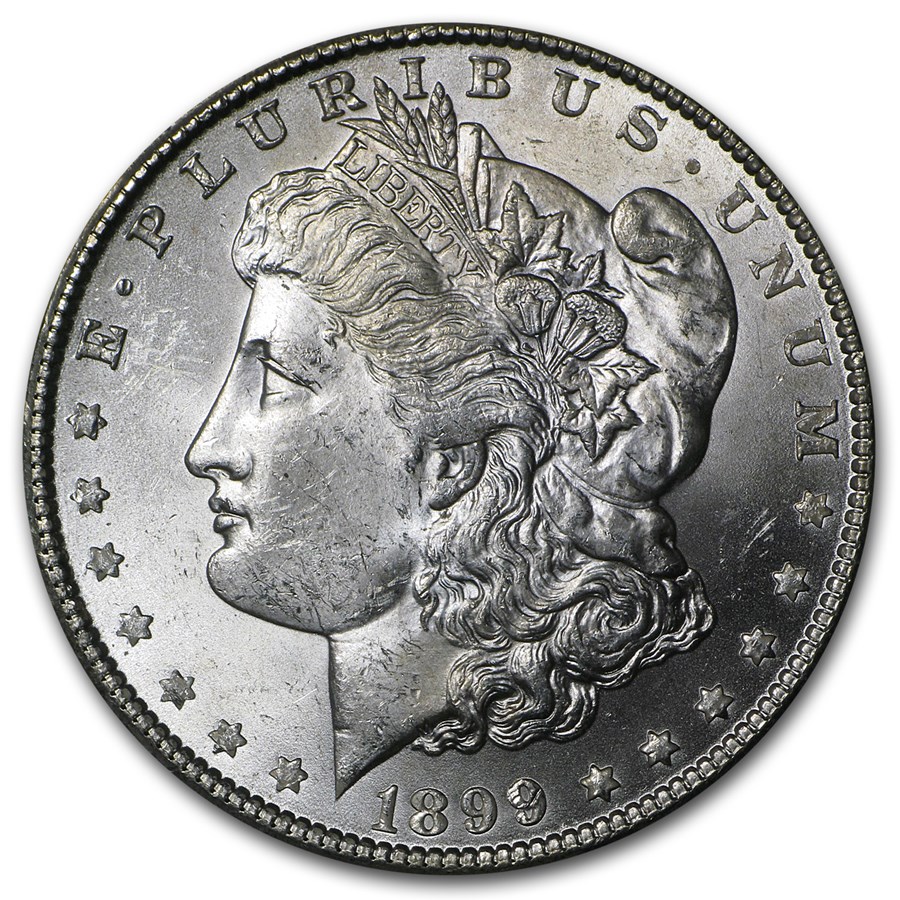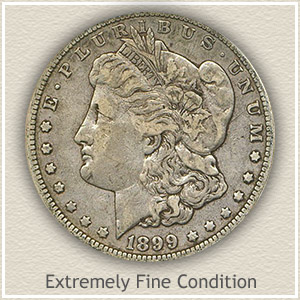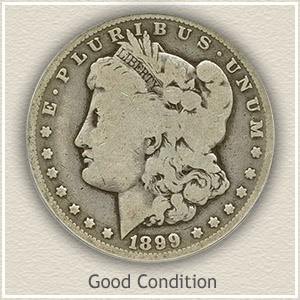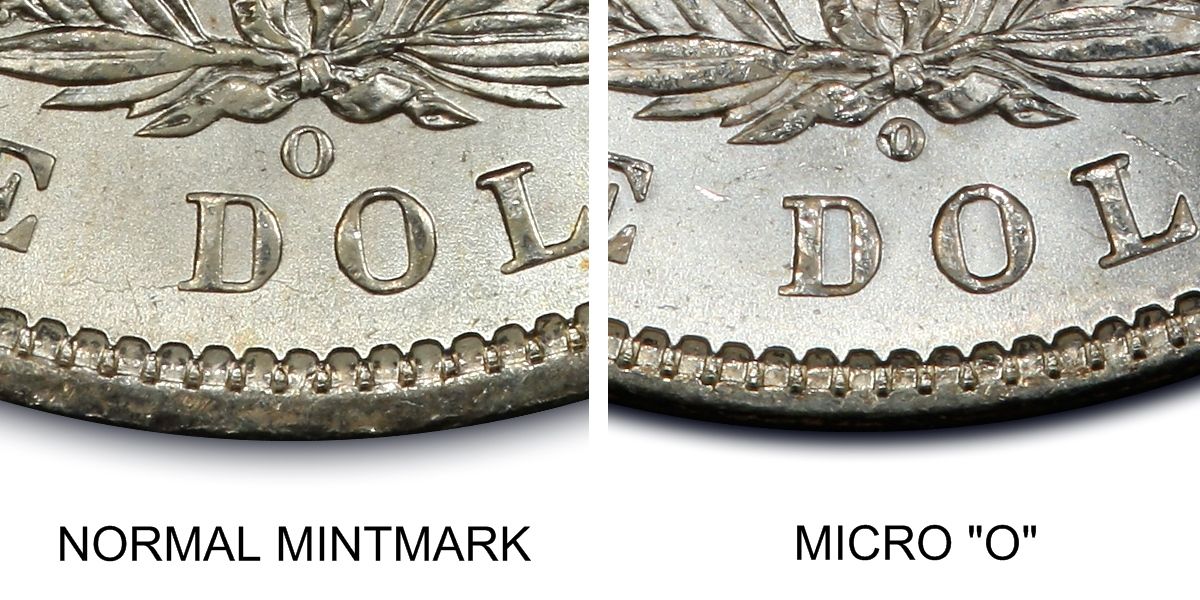1899 Silver Dollar

The 1899 Morgan Silver Dollar was produced in three mints: New Orleans, Philadelphia, and San Francisco. The New Orleans Mint used an 'O' and the San Francisco Mint an 'S”. The main mint in Philadelphia did not use a mintmark. Proof examples of Morgan Dollars from all years, including 1899, are rare which makes them expensive.
- The 1899 silver dollar with no mint mark is worth around $175 in very fine condition. In extremely fine condition the value is around $185. In uncirculated condition the price is around $260 for coins with an MS 60 grade. Uncirculated coins with a grade of MS 65 can sell for around $700.
- Value of 1899 Morgan Silver Dollar A comparatively low number of Philaldephia Mint 1899 Morgan Silver Dollars were struck and very few were released into circulation at the time of production. The low mintage figure has always appealed to collectors and investors who figured these coins to be worth more.
- This collectible 1899-P Morgan Silver Dollar makes a great addition to any collection. Struck in 1899 by the historic Philadelphia Mint. This Morgan Silver Dollar is needed by anyone hoping to build a complete date and mint mark collection, so you`ll want to order today!
Year: 1899
Denomination: One Dollar Bank Note
Type: Silver Certificate
$1 Bill Front Picture:
Description: This is commonly called a black eagle or just an eagle for obvious reasons.
Seal Type: All large $1 silver certificates have the same blue seal as seen above.

Varieties: There are thirteen different types of 1899 $1 silver certificates. The type is very important. Most varieties are very common; however, some are very rare in high grades.
Portrait: Abraham Lincoln & Ulysses Grant
Value: The majority of 1899 $1 silver certificates sell for around $50. Notes that show very few signs of circulation can be worth between $100 and $200. There are lots of low serial number and star notes from the series of 1899. Anything with a one or two digit serial number is a good find. Please send some pictures of your $1 bill if you would like an exact value.
NEED AN APPRAISAL OR WANT TO SELL?
We buy all of these 1899 $1 bank notes from The United States. The seal type, signature combination, serial number, and condition are very important. We have to see pictures in order to provide any value information. You can text pictures to 864-430-4020. You can also attach pictures to an email message. Please give us a chance to make an offer. The value might surprise you in a good way.
History: The United States printed two dollar silver certificates for a very short period of time. The series years are 1886, 1891, 1896, and 1899. As you can tell from that listing, the 1899 $2 silver certificate that we are detailing here is the last design type used for the denomination. Generally speaking, 1899 two dollar bills are fairly common. Despite saying 1899, some of these bills were printed as late as the 1920s. So some 1899 $2 silver certificate aren’t quite as old as the series year would suggest. There are ten different signature combinations. You can determine the age of your bill (within a couple years) based on the signatures. This is what is known as a one year design type. None of the design elements were ever used on future series years.
Nickname: 1899 $2 silver certificates are most often called “mini-portholes” by collectors. This nickname is a bit confusing. The front of the bill has a portrait of George Washington. It looks like George Washington is observing the viewer from inside a ship’s porthole. The 1923 $5 silver certificate has a similar design with Abraham Lincoln and it is called a porthole ntoe. I guess that nickname was claimed, so the 1899 $2 bill became the mini-porthole. The nickname is well known by collectors, but it is not used especially frequently.
Other Facts: It terms of portraiture on currency, no one really expects to see George Washington on a two dollar bill. In fact, the 1899 $2 silver certificate is the only bill of that denomination on which George Washington is pictured. He first appeared on one dollar bills in 1869, and he appeared on twenty dollar gold certificates starting in 1905. He got around. The design on this note is sometimes called the agriculture and mechanics layout. The male and female figures are supposed to represent those two industries.
Values and Grading: It is generally accepted that April 2008 was the peak of the collectible currency market. The 1899 $2 silver certificate was hit hard when the market dropped along with the rest of the economy. Something that used to sell for $3,500 might only bring $2,000 in today’s market. Star notes were issued for several of the mini-porthole’s signature combinations. Star notes are also down in value by about 40%. Part of the reason values have come down is due to the fact that the 1899 $2 bill is not iconic or especially popular. The note is of course needed to complete a type set, silver certificate set, or two dollar bill set. However, it doesn’t have much appeal to cross collections. With that said, some examples can still be especially valuable. It all comes down to the condition. Read below to learn more about condition.
Choice Uncirculated or Better: The 1899 $2 silver certificate we have pictured below has been graded as choice uncirculated 65. It would typically sell for around $1,500 on good day. The term uncirculated is associated with pieces of currency that grade anywhere from 63 to 70. You are most likely to see grades in the 64 to 66 range. Anything above 67 is unusually high and should sell for mid-four figures. Once you get above 65 then the centering becomes especially important. Many 1899 $2 silver certificates don’t have great centering. So if you have a note that has perfectly even white margin all the way around the bill then it will be worth more money than the same bill with lopsided borders.
This 1899 $2 Bill Is In Perfect Condition. We Pay $1,500 For Similar Notes.
Extremely Fine to About Uncirculated: Any 1899 $2 silver certificate in extremely fine condition should show two or three folds. It will have great color and bright white paper. Notes in about uncirculated condition will look very similar except that they should have no more than one fold. It is not uncommon for unscrupulous dealers to take an 1899 $2 bill in XF or AU condition and press it out so that it appears to not have any folds at all. So be careful if you are considering purchasing something in this grade.
We Pay As Much $300 For Lightly Circulated 1899 $2 Bills
Fine to Very Fine: We see a lot of 1899 $2 silver certificates in the Fine 12 to Very Fine 20 range. Notes like that usually sell for a price between $100 and $200. Slightly nicer examples that would grade 25 to 35 are going to sell for something in the two hundreds. The note we have pictured below is on the very low end of this grade range. The note above is a 35 and the note below is 12. There is a tremendous difference in terms of paper quality and eye appeal. It is not a surprise that most collectors don’t mind spending more money to get the higher grade example.
1899 $2 Silver Certificates In This Condition Generally Sell For Around $125
Very Good and Lower: 1899 $2 silver certificates that grade a 10 or lower (out of 70) are referred to as very good, good, about good, fair, or poor. The note we have pictured below actually graded as a 4. You can see that the paper is extremely well used. It is dark and stained from years spent in circulation. Notes like this are typically bought more for their curiosity value rather than their numismatic value. For only $100 more you can get something that looks much better, so very few people want to settle for such a ragged example.

1899 Silver Dollar Worth
This 1899 $2 Bill Is Heavily Circulated And Only Worth About $50


1899 Silver Dollar Coin Value
Need an Appraisal or Offer? We buy 1899 $2 silver certificates in any condition. We are especially looking for high grade examples, low serial numbers, and star notes. Please contact us via email if you have anything for sale. We would be happy to make an offer and give a free appraisal. Sales@AntiqueMoney.com